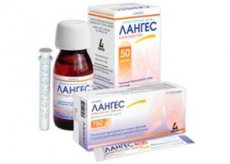Medical expert of the article
New publications
Preparations
Langes
Last reviewed: 03.07.2025

All iLive content is medically reviewed or fact checked to ensure as much factual accuracy as possible.
We have strict sourcing guidelines and only link to reputable media sites, academic research institutions and, whenever possible, medically peer reviewed studies. Note that the numbers in parentheses ([1], [2], etc.) are clickable links to these studies.
If you feel that any of our content is inaccurate, out-of-date, or otherwise questionable, please select it and press Ctrl + Enter.

Langes is a mucolytic agent that contains the active ingredient carbocysteine.
Indications Langesa
It is indicated for eliminating signs of bronchial secretion disorder, as well as sputum removal processes. This is especially true for acute forms of bronchopulmonary pathologies (for example, acute bronchitis). In addition, the drug is used during exacerbations of chronic forms of respiratory pathologies.
Release form
It is available as a solution in 60 or 200 ml bottles. The 60 ml bottle comes with a dosing syringe, and the 200 ml bottle comes with a measuring cup. It can also be contained in 15 ml sachets, with 12 sachets inside one package.
Pharmacodynamics
Carbocisteine affects the gel stage of mucus passage inside the respiratory tract. It breaks the disulfide bonds of glycoproteins, resulting in the liquefaction of the overly viscous secretion produced by the bronchi. The substance also helps remove phlegm from the lungs.
The mucoregulatory effect of the active component is due to the activation of sialic transferase (an enzyme located inside the bronchial mucosa - in enterocytes). Carbocisteine stabilizes the proportions of neutral and acidic sialomucins found in the secretion secreted by the bronchi and helps restore their elasticity and viscosity.
Stimulates the function of the ciliated epithelium and improves the functioning of the mucociliary system. Helps regenerate the mucous membrane of the respiratory tract, heals its structure, reduces enterocyte hyperplasia, which reduces mucus production.
It helps restore the secretion of the immunoactive element IgA (as a specific defense), and also the number of thiol groups of mucus elements (as a non-specific defense). It has an anti-inflammatory effect, which develops with the help of the kinin-inhibiting activity of sialomucins. This helps reduce swelling and relieve bronchial obstruction.
 [ 7 ]
[ 7 ]
Pharmacokinetics
When administered orally, the drug is rapidly absorbed through the gastrointestinal tract. Peak plasma levels are observed after 2 hours. The bioavailability of carbocysteine is very low (approximately 10% of the dose taken), because intensive metabolism occurs in the gastrointestinal tract. This value is also affected by the effect of the "first pass" in the liver.
The half-life is 2 hours. The excretion of the active ingredient and its decay products occurs mainly with urine.
Dosing and administration
The medicine is taken orally. The dose depends on the age of the patient:
- children aged 2-5 years are prescribed 2 ml twice a day (60 ml bottles are used);
- children aged 5-15 years are prescribed 2 ml three times a day (60 ml bottles are used);
- children over 15 years old, as well as adults - 15 ml or 1 sachet three times a day (200 ml bottles or sachets are used).
Children under 15 years of age should not be given more than 2 ml of the medicine (100 mg) at a time.
The therapeutic course should last a maximum of 8-10 days. For children, the maximum possible course duration should not be longer than 5 days.
For teenagers aged 15 and over and adults, use a solution from 200 ml bottles or sachets, and for children aged 2-15, use 60 ml bottles. To accurately measure the dose, use a measuring cup (200 ml bottles) or a dosing syringe (60 ml bottles).
Use Langesa during pregnancy
It is prohibited to prescribe the medicine in the 1st trimester. During the 2nd-3rd trimester or during lactation, Langes is used exclusively under the supervision of a doctor and only in cases where the benefit to the woman outweighs the possible risk of complications in the fetus.
Contraindications
Among the contraindications:
- hypersensitivity to carbocysteine or other components of the drug (especially methylparaben and other parahydroxybenzoate salts);
- gastric ulcer or duodenal ulcer, during periods of exacerbation;
- children under 2 years of age.
Side effects Langesa
The use of the drug may cause certain side effects:
- gastrointestinal tract: vomiting, indigestion, abdominal pain, nausea, and diarrhea;
- CNS organs: the appearance of a feeling of weakness or malaise, as well as severe dizziness;
- allergic manifestations: urticaria, itching, Quincke's edema, and exanthema may occasionally occur (symptoms may be distant in time).
If the patient develops side effects, the dosage should be reduced or the drug should be discontinued, and a doctor should be consulted.
Interactions with other drugs
During the use of Langes, it is recommended to avoid antitussive drugs, as well as drugs that inhibit the secretion process in the bronchi.
In combination with antibacterial drugs, their effectiveness is enhanced. Also, there is a mutual enhancement of the properties of Langes and GKS (when combined).
Storage conditions
The medicine must be stored under normal conditions for medicinal products, inaccessible to children. The temperature value is a maximum of 25 o C.
 [ 29 ]
[ 29 ]
Shelf life
Langes is suitable for use for 2 years from the date of its manufacture. But after opening the bottle, the shelf life of the drug is 1 year.
Attention!
To simplify the perception of information, this instruction for use of the drug "Langes" translated and presented in a special form on the basis of the official instructions for medical use of the drug. Before use read the annotation that came directly to medicines.
Description provided for informational purposes and is not a guide to self-healing. The need for this drug, the purpose of the treatment regimen, methods and dose of the drug is determined solely by the attending physician. Self-medication is dangerous for your health.

